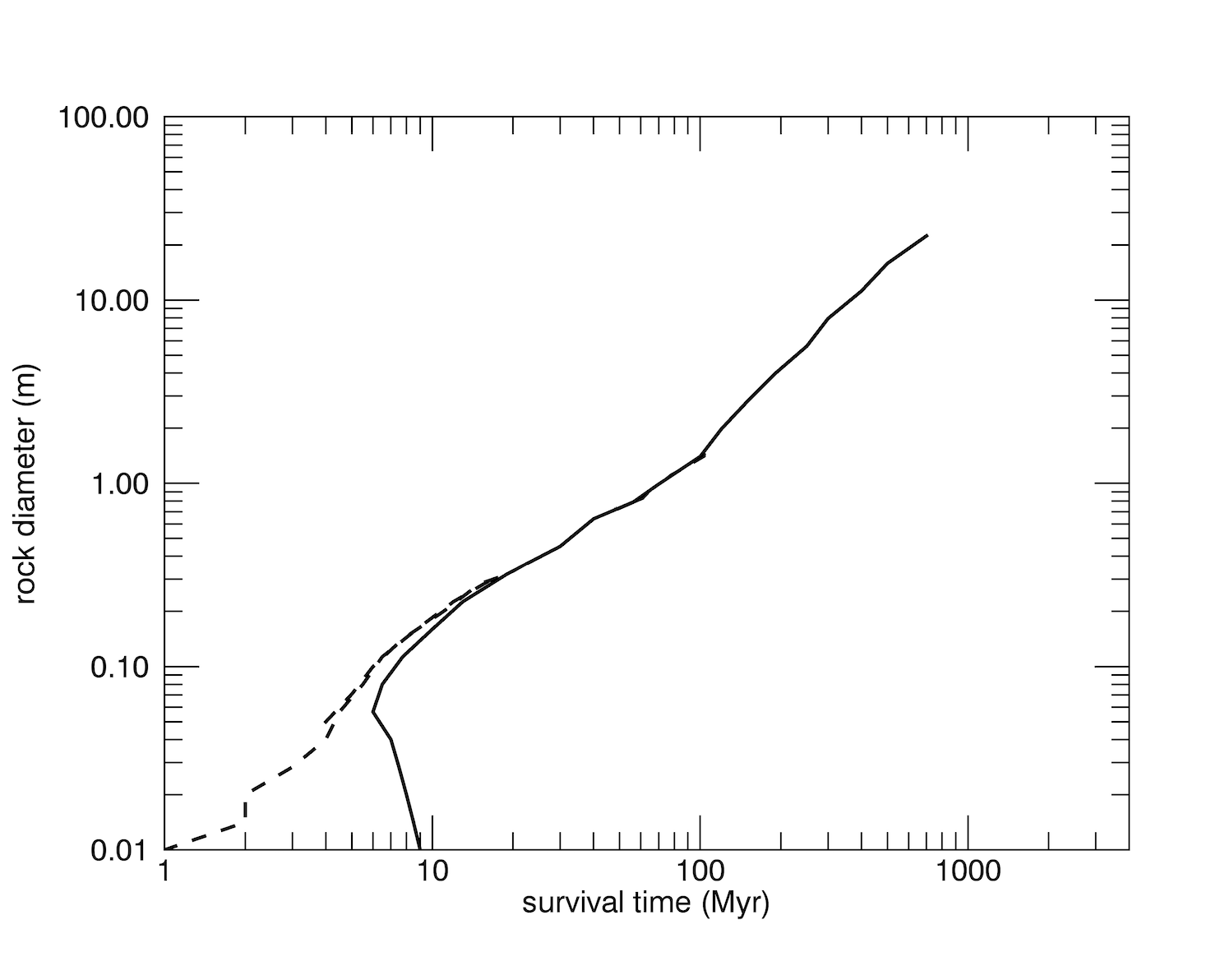Destruction rates of lunar rocks (1cm to 60 m) by impact shattering
- Westfälische Wilhelms Universität Münster, Institut für Planetologie, Münster, Germany (ottaviano.ruesch@uni-muenster.de)
The shattering and abrasion of boulders on the Moon produce regolith. The study of these processes is thus relevant for our understanding of the nature and evolution of the lunar surface. The shattering rate, i.e., the erasure rate, of boulders on the Moon [e.g., Hörz et al., 1975] has been recently updated in [Rüsch et al., 2022]. Here we present the effect of low velocity secondaries on the erasure rate of boulders.
The model presented in [Rüsch et al., 2022] tracks the energy imparted by meteoroids on lunar boulders of different sizes. The imparted energy is a function of the size-frequency distribution and flux of meteoroids, and their velocity probability function. After having accumulated a certain amount of energy, through either one or multiple impacts, a boulder shatters and appears undetectable in images (“erased”). The shattering threshold behind which lunar boulders “disappear” is size dependent as described by the specific energy function [e.g., Housen and Holsapple, 1999; Benz and Asphaug, 1999]. This threshold has been determined using the size-frequency distribution of a boulder fields of known radiometric age on the Moon (Tycho). In addition to meteoroids with their characteristic high velocity (~10s km/s) the model also considers low velocity (0.5 km/s) impactors that represent secondaries, i.e., ejecta from primary impact craters. The flux and size-frequency of these secondaries is described in [Costello et al., 2018].
As presented in [Rüsch et al., 2022], the destruction rate for boulders larger than ~1 m is controlled by the flux of high velocity meteoroids. The rate for boulders smaller than ~1 m, instead, is dominated by the impact of low-velocity projectiles (Figure 1). For ~1 cm sized boulder, the destruction rate including low-velocity secondaries is about one order of magnitude higher relative to the rate due to primary alone. Despite the low velocity, the high number of secondaries, produced by the -4 exponent of the size frequency distribution power law, has a non-negligeable effect on small rocks.
If the model of lunar secondaries [Costello et al., 2018] considered here is valid, the erosion rates measured on cm-sized rocks returned by the Apollo missions [e.g., Hörz et al., 1975] represent the combined effects of meteoroids as well as secondaries. This result should be considered when erosion rates of Apollo samples are extrapolated to other bodies.

Figure 1. The survival time is defined as the time after which there is a 90% probability for a rock of given diameter to be erased. The solid line represents the effect of high velocity meteoroids. The dashed line represents the combined effects of high velocity meteoroids and low-velocity secondaries, i.e. ejecta of primary craters. Small irregularities in the curves are model artifacts.
References:
Costello, E.S., Ghent, R.R., Lucey, P.G., 2018. The mixing of lunar regolith: vital updates to a
canonical model. Icarus 314, 327–344
Housen, K.R., Holsapple, K.A., 1999. Scale effects in strength-dominated collisions of rocky
asteroids. Icarus 142, 21–33.
Benz, W., Asphaug, E., 1999. Catastrophic disruptions revisited. Icarus 142, 5–20.
Hörz, F., Schneider, E., Gault, D.E., Hartung, J.B., Brownlee, D.E., 1975. Catastrophic rupture
of lunar rocks: a Monte Carlo simulation. The Moon 13, 235–258.
Rüsch, O., Marshal, R. M., Iqbal, W., Pasckert, J. H., van der Bogert, C. H., Patzek, M., 2022, A Model for the Evolution of Lunar Rock Size-Frequency Distributions, LPSC 53rd, LPI Contribution No. 2678, id.1376.
How to cite: Ruesch, O., Marshal, R., Iqbal, W., Pasckert, J. H., van der Bogert, C., and Pasckert, M.: Destruction rates of lunar rocks (1cm to 60 m) by impact shattering, Europlanet Science Congress 2022, Granada, Spain, 18–23 Sep 2022, EPSC2022-916, https://doi.org/10.5194/epsc2022-916, 2022.

